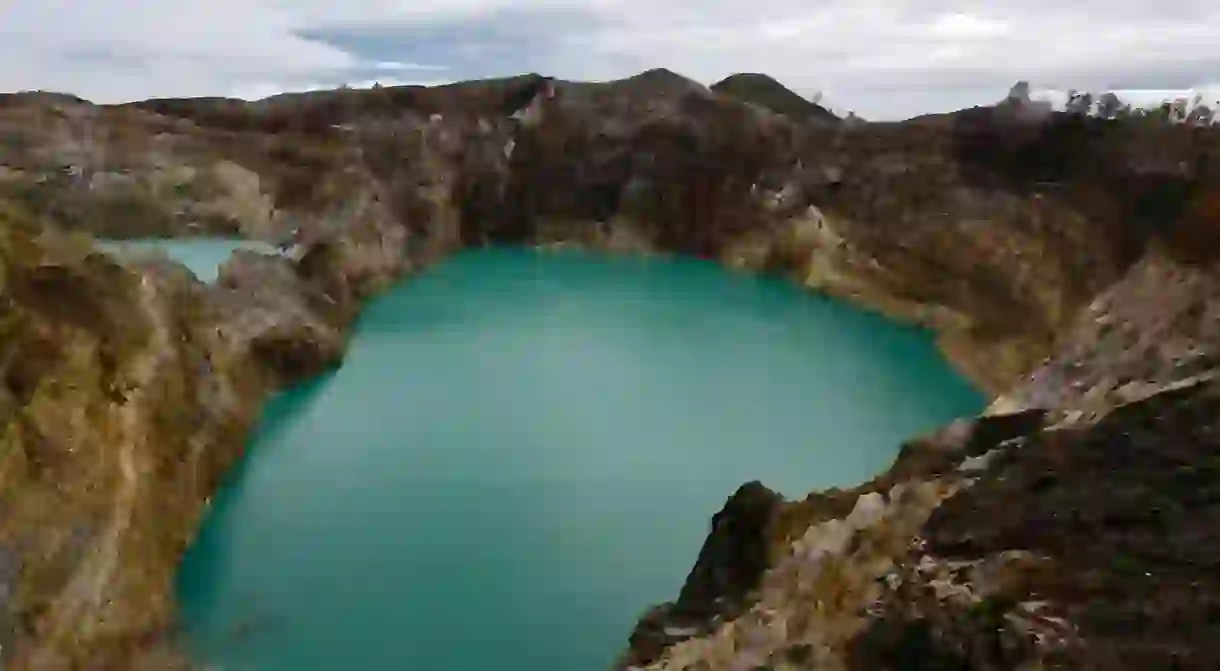A Guide to Indonesia's Azure Blue Kelimutu Lake

Also known as the ‘three-colored lake’, Kelimutu Lake is one of the most sought-after sights in the Indonesian archipelago, partly for its scenic view, but also for the captivating stories it carries. From getting there to local legends, read on for a guide to Indonesia’s azure blue Kelimutu Lake.
Located on the top of Mount Kelimutu in Flores, East Nusa Tenggara, Indonesia, a trip to the mesmerizing Kelimutu Lake is rather demanding. After hours of road trip from the nearest airport in Ende Regency, the journey continues with an hour of trekking, followed by hundreds of steps to climb in the cold morning mist. But even then, the natural magnetism is already strong, intensifying with every step you take closer to the famed lake.

Kelimutu Lake is located 1,639 meters above sea level, on the top of the Kelimutu volcano. The name came from local dialect keli that means mountain, and mutu, which means boiling.

Also known as the three-colored lake, Kelimutu Lake actually comprises three separate lakes, each with a different color. Two of the lakes are separated only by a rather thin crater wall, while the other one is a bit further away.

Locals name the three lakes according to the myth it carries. Basically, the lakes at Kelimutu are believed to be the dwelling place for the spirits. Tiwu Nuwa Muri Koo Fai is where the young souls reside, those who died at a young age or unmarried. This lake is the largest and deepest of all three.

Next to it is the Tiwu Ata Polo, which is where the bewitched souls rest, those who did evil or practiced sorcery during their time alive.

Tiwu Ata Mbupuis the resting place for the elderly souls, those who died at an old age. This is the westernmost of all the three lakes and separated from the other two.

The three lakes of Kelimutu are known to change colors. The lake of young souls is usually different shades of blues or greens. The lake of bewitched souls has been brown, green, and dark red, while the lake of old souls has shown different tones of brown and white.

The changing of colors is due to the volcanic gas, microbes activity, change in temperature, and crater wall erosion. The first record of shifting colors was after the mountain’s 1886 eruption, and since then the lakes have been altering colors dozens of times, independently of each other.

Even though the color-altering phenomenon can now be explained scientifically, myths and legends have long been passed around and adopted by locals. The Lio tribe of Flores believe that the changing of colors reflects the political atmosphere of the country. Calming blues or greens represent a peaceful national condition, while red indicates a political turmoil. Others simply state that warm colors are indicative of calamity and cool colors represent a state of calmness and stability.

Another myth says that if the crater walls collapse somehow, causing the three lakes to merge into one, it means the end of the world is imminent.

The discovery of this magnificent lake is attributed to a Dutchman named Van Such Telen in 1915. He described the lake as ‘red, white, and blue’, which happens to be the flag colors of the Netherlands. Locals were sceptic about the whole discovery, and a many of them embarked on a journey to see the sight for themselves. And there they were, the three lakes, depicting the political atmosphere of the nation at the time.

The three lakes have been showing calming azure shades for a while, even the Tiwu Ata Polo, which was burning red in April 2017, supposedly due to the mountain’s volcanic activity.


Each year, usually on August 14, a traditional ritual is held to honor the ancestral spirit. The festival, called Pati Ka Du’a Bapu Ata Mata, starts with a walking procession up the mountain to the stone altar near Tiwu Ata Polo.

Various kinds of food offerings will be presented at the alter, followed by ceremonial performances that last throughout the day.

Beyond the mesmerizing colors of the lakes, the mountaintop also presents a wonderful highland landscape, with hills, greenery, and faraway peaks.

One of the most popular times to see this magical lake is during sunrise, where the orange sky meets the azure lake, and casts a warm shade to the already colorful surface.

The most popular hub for travelers to reach this magnificent lake is the Koanara Village, which is about three-hours drive away from the airport at Ende by bus or rented car. If you’re feeling adventurous, a motorcycle taxi (ojek) will let you set your own pace while exploring the route. From Koanara Village, Kelimutu Lake is only about 2.5 kilometers away.

Up the mountain and approaching the lake, the temperature may get rather low with high humidity, creating a mystical feel and crisp natural atmosphere.

So if you spot any of these tiny food vendors, stop by to get a cup of hot coffee, tea, or water, even cup instant noodles. You’ll need it to keep warm inside.

The traditional pattern fabric will also help you confront the cold breeze. Plus, it looks exotic and helps the local economy.

Finally, take time to interact with locals. They’ll spill you more unimaginable local stories and legends that not only will entice your eyes, but also your mind.














